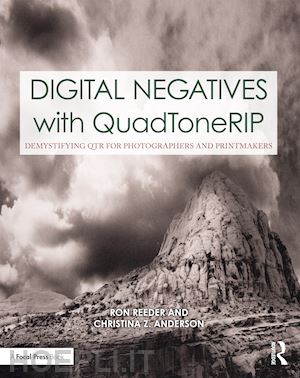Digital Negatives with QuadToneRIP is a text that fully explores how the QuadToneRIP printer driver can be used to make expert digital negatives. The book takes a comprehensive, Òunder-the-hoodÓ look at how Roy Harrington’s QTR printer driver can be adapted for use by artists in several different creative practice areas. The text is written from the Mac/Photoshop point of view. The book is divided into three parts. Part One is a step-by-step how-to section that will appeal to both beginning and more advanced practitioners. Part One includes quickstart guides or summary sheets for beginning students who want to jump into using QTR before understanding all of its functional components. Part Two addresses dimroom, darkroom, and printmaking practices, walking the reader through brief workflows from negative to print for lithium palladium, gum bichromate, cyanotype, salted paper, kallitype, silver gelatin and polymer photogravure, with a sample profile for each. It also includes an introduction to a new software iteration of QTR: QuickCurve-DN (QCDN). Part Three is devoted to contemporary practitioners who explain how they use QTR in their creative practice. The book includes: A list of supplies and software needed A summary QTR glossary with a simple explanation of how each function works A sample walk-through to create a QTR profile from start to finish How to linearize profiles with simple to more exacting tools A visual guide to modifying functions Quickstart guides for many of the workflows Instructions for crafting monochrome, duotone, tricolor, and quadcolor negatives Instructions for using QTR to print silver gelatin in the darkroom Instructions for using QTR to print alternative processes in the dimroom Instructions for using QTR to print polymer photogravure in the printmaking room Introductory chapter to QuickCurve-DN software Troubleshooting common QTR problems Generic starter profiles for processes discussed Contemporary artists: their work and QTR process. Learning how to craft expert digital negatives can be a bit overwhelming at the outset. Digital Negatives with QuadToneRIP makes the process as user-friendly as possible. Like other books in the series, Digital Negatives with QuadToneRIP is thoroughly comprehensive, accessible to different levels of learner, and illustrative of the contemporary arts.











